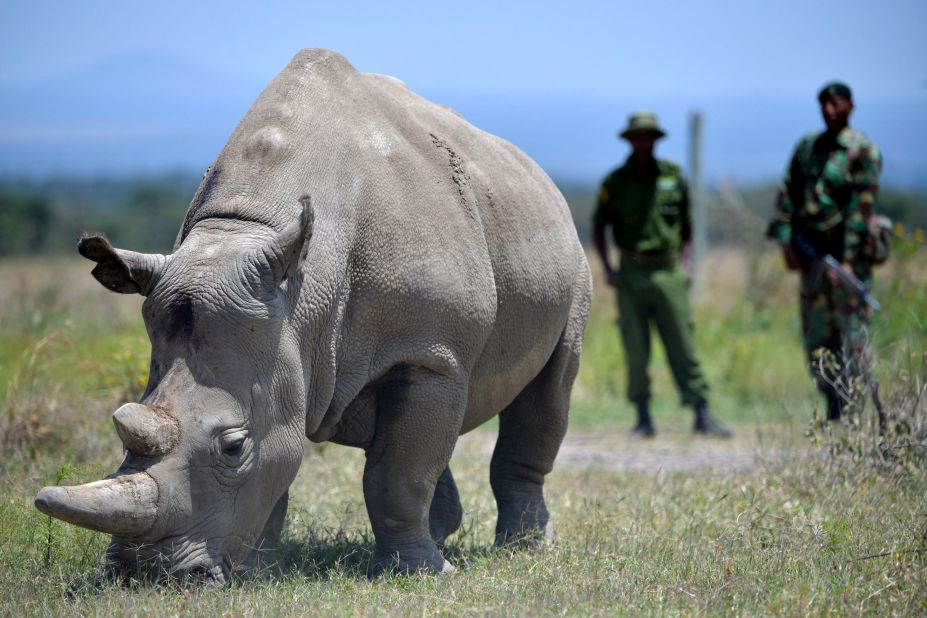Science & Technology
Conserving Northern White Rhino Through Surrogacy
- 03 Feb 2024
- 6 min read
For Prelims: Northern White Rhino, in-vitro fertilization (IVF), Surrogacy, Indian rhinoceros
For Mains: Surrogacy Associated Challenges, Role of Biotechnology in the Conservation of Extinct species
Why in News?
The northern white rhino (NWR) is one of the most endangered animals on the planet, with only two females left alive. In a bid to rescue this species, scientists embarked on an ambitious project named BioRescue in 2015, employing reproductive technologies like in-vitro fertilization (IVF) and stem cell techniques.
- Recently, the international consortium, BioRescue, announced the first-ever rhino pregnancy through a lab-made embryo transferred to a southern white rhino.
- This endeavour represents a beacon of hope for the survival of the northern white rhino.
How are Scientists Creating Test Tube Rhinos?
- In-Vitro Fertilization (IVF) Breakthrough:
- BioRescue, an international consortium of scientists, achieved a historic milestone with the first-ever rhino pregnancy through IVF.
- The process involved transferring a lab-made rhino embryo into a surrogate southern white rhino.
- BioRescue, an international consortium of scientists, achieved a historic milestone with the first-ever rhino pregnancy through IVF.
- Surrogacy:
- The death of the last male northern white rhino in 2018 made surrogacy the only viable option for species regeneration.
- The remaining two females, Najin and Fatu, were found incapable of reproduction for pathological reasons.
- The only hope for the NWR is to use frozen sperm from deceased males and eggs from the females to create embryos in the laboratory, and then implant them into surrogate mothers from the southern white rhino (SWR) subspecies, which is more abundant and genetically similar.
- The death of the last male northern white rhino in 2018 made surrogacy the only viable option for species regeneration.
- Concerns Regarding the Test Tube Rhinos:
- Genetic Viability Concerns:
- Embryos used in the process are derived from eggs of two females and sperm from deceased males, limiting the gene pool for a viable northern white population.
- Preserving Northern White Rhino Traits:
- Crossbreeding with southern white rhinos is not a solution, as it would result in the loss of unique attributes of the northern white, adapted for swampy habitats.
- Genetic diversity remains a concern even with successful IVF and surrogacy attempts.
- Crossbreeding with southern white rhinos is not a solution, as it would result in the loss of unique attributes of the northern white, adapted for swampy habitats.
- Behavioral Challenges in IVF Offspring:
- Babies born through IVF are not genetically hardwired to exhibit typical northern white rhino behaviours.
- Early interaction and learning from northern white adults are crucial for maintaining species-specific traits.
- The urgency lies in the age of the remaining northern white females, Najin (35) and Fatu (24).
- To ensure behavioral and social skills are passed on, the first IVF calves must be born in time to learn from the surviving females.
- Babies born through IVF are not genetically hardwired to exhibit typical northern white rhino behaviours.
- Conservation Beyond Test Tubes:
- Critics argue that the focus should not only be on species regeneration but also on addressing the root causes of extinction, such as habitat threats and poaching.
- Genetic Viability Concerns:
Surrogacy:
- It is an arrangement in which a woman (the surrogate) agrees to carry and give birth to a child on behalf of another person or couple (the intended parent/s).
- A surrogate, sometimes also called a gestational carrier, is a woman who conceives, carries and gives birth to a child for another person or couple (intended parents).
What are the Key Facts Regarding the Northern White Rhino?
- About:
- The NWR is a subspecies of the white rhino (Ceratotherium simum), which is native to central and eastern Africa.
- White rhinos are the second largest land mammal after the elephant. They are known as the square-lipped rhinoceros, white rhinos have a square upper lip with almost no hair.
- The northern and southern white rhino are two genetically distinct subspecies of the white rhino.
- Current Status:
- The IUCN Red List Status of White Rhino is Near Threatened. The IUCN status of its subspecies is as follows:
- Northern White Rhino: Critically Endangered.
- Southern White Rhino: Near Threatened.
- The NWR population has declined dramatically due to poaching, habitat loss, civil war, and disease.
- In the 1960s, there were about 2,000 NWRs in the wild. By 2008, only four remained.
- The last male NWR, named Sudan, died in 2018, leaving only two females, Najin and Fatu, who live in a conservancy in Kenya.
- In the 1960s, there were about 2,000 NWRs in the wild. By 2008, only four remained.
- The majority (98.8%) of the southern white rhinos occur in just four countries: South Africa, Namibia, Zimbabwe, and Kenya.
- Southern white rhinos are around 18,000 animals that exist in protected areas and private game reserves.
- The IUCN Red List Status of White Rhino is Near Threatened. The IUCN status of its subspecies is as follows:
Note
- The Indian rhinoceros (also known as the greater one-horned rhinoceros) is different from the African rhinos and it is listed as vulnerable on the IUCN Red List.
UPSC Civil Services Examination, Previous Year Question
Prelims
Q. In the context of recent advances in human reproductive technology, “Pronuclear Transfer” is used for (2020)
(a) fertilization of egg in vitro by the donor sperm
(b) genetic modification of sperm producing cells
(c) development of stem cells into functional embryos
(d) prevention of mitochondrial diseases in offspring
Ans: (d)





